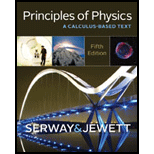
Concept explainers
(a)
The minimum average distance by which the target was missed.
(a)
Answer to Problem 40P
The minimum average miss distance is
Explanation of Solution
The initial height of the pellet is
Write the given expression for deviation from the target
Here,
Write the uncertainty relation.
Here,
Substitute (I) and rearrange
Write the expression for change in velocity using equation of motion
Here,
Substitute
Write the expression for time taken to reach distance
Substitute (IV) and (II) in (I)
Find the uncertainty in initial position by differentiating the above equation with respect to
Since the second derivative of equation (V) is positive. The above found
Rearrange for
Conclusion
Substitute
Thus, the minimum average miss distance is
(b)
Find the average miss distance given the mass and height.
(b)
Answer to Problem 40P
The average miss distance is
Explanation of Solution
The mass of the pellet is
Substitute
Thus, the average miss distance is
Want to see more full solutions like this?
Chapter 28 Solutions
Principles of Physics
- Suppose the x-component of the velocity of an electron has been measured to an accuracy of 10 -2 mm/s. What is the minimum uncertainty in the position along the x-axis? And along the y-axis?arrow_forwardA beam of α particles of kinetic energy E = 10 MeV and intensity I = 1 μ A hits a lead target [A = 207, Z = 82, ρ = 1.14 x 104 kg m-3] of thickness t = 0.2 mm. We locate a counter of area S = 1 cm2 at a distance of l = 0.5 m beyond the target at the angle θ = 40°. Neglecting, when necessary, the variation of the angle on the detector find: (a) the number of incident particles per second Ri, (b) the solid angle ΔΩ under which the target sees the detector, (c) the differential cross-section at the detector, and (d) how many hits the detector counts per second.arrow_forwardA proton is confined to a nucleus whose diameter is 5.5 × 10^−15 ?. If this distance is considered to be the uncertainty in the position of the proton, what is the minimum uncertainty in its momentum?arrow_forward
- A laser emits at 424 nm in a single pulse that lasts 0.500 ms. The power of the pulse is 2.80 MW. If we assume that the atoms contributing to the pulse underwent stimulated emission only once during the 0.500 ms,how many atoms contributed?arrow_forwardPhotoconductivity and speed Consider two p-type Si samples both doped with 1015 B atoms cm−3. Both have identical dimensions of length L (1 mm), width W (1 mm), and depth (thickness) D (0.1 mm). One sample, labeled A, has an electron lifetime of 1 μs whereas the other, labeled B, has an electron lifetime of 5 μs. a. At time t = 0, a laser light of wavelength 750 nm is switched on to illuminate the surface (L × W) of both the samples. The incident laser light intensity on both samples is 10 mW cm−2. At time t = 50 μs, the laser is switched off. Sketch the time evolution of the minority carrier concentration for both samples on the same axes. b. What is the photocurrent (current due to illumination alone) if each sample is connected to a 1 V battery?arrow_forwardWhat is the kinetic energy of each electron in a beam of electrons if the beam produces a diffraction pattern of a crystal which is similar to that of a beam of 1.00 eV neutrons? (knowing that electron mass is 9.11*10^-31 kg and neutron mass is 1.67*10^-26 kg).arrow_forward
- Suppose the fractional efficiency of a cesium surface (with work function 1.80 eV) is 1.0 * 10-16; that is, on average one electron is ejected for every 1016 photons that reach the surface.What would be the current of electrons ejected from such a surface if it were illuminated with 600 nm light from a 2.00 mW laser and all the ejected electrons took part in the charge flow?arrow_forwardIf the uncertainty in the y -component of a proton's position is 2.0 pm, find the minimum uncertainty in the simultaneous measurement of the proton's y -component of velocity. What is the minimum uncertainty in the simultaneous measurement of the proton's x -component of velocity?arrow_forward
 Physics for Scientists and Engineers with Modern ...PhysicsISBN:9781337553292Author:Raymond A. Serway, John W. JewettPublisher:Cengage Learning
Physics for Scientists and Engineers with Modern ...PhysicsISBN:9781337553292Author:Raymond A. Serway, John W. JewettPublisher:Cengage Learning Principles of Physics: A Calculus-Based TextPhysicsISBN:9781133104261Author:Raymond A. Serway, John W. JewettPublisher:Cengage Learning
Principles of Physics: A Calculus-Based TextPhysicsISBN:9781133104261Author:Raymond A. Serway, John W. JewettPublisher:Cengage Learning Modern PhysicsPhysicsISBN:9781111794378Author:Raymond A. Serway, Clement J. Moses, Curt A. MoyerPublisher:Cengage Learning
Modern PhysicsPhysicsISBN:9781111794378Author:Raymond A. Serway, Clement J. Moses, Curt A. MoyerPublisher:Cengage Learning University Physics Volume 3PhysicsISBN:9781938168185Author:William Moebs, Jeff SannyPublisher:OpenStax
University Physics Volume 3PhysicsISBN:9781938168185Author:William Moebs, Jeff SannyPublisher:OpenStax



